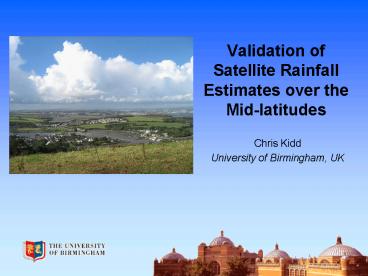Validation of Satellite Rainfall Estimates over the Midlatitudes - PowerPoint PPT Presentation
1 / 34
Title:
Validation of Satellite Rainfall Estimates over the Midlatitudes
Description:
Validation of Satellite Rainfall Estimates over the Mid-latitudes. Chris Kidd ... Resampled/remapped imagery. Scatterplot. Rainfall intensity distribution ... – PowerPoint PPT presentation
Number of Views:119
Avg rating:3.0/5.0
Title: Validation of Satellite Rainfall Estimates over the Midlatitudes
1
Validation of Satellite Rainfall Estimates over
the Mid-latitudes
- Chris Kidd
- University of Birmingham, UK
2
The European Context
- Geographically diverse
- Large extent of coastlines and interiors
- Plains mountains
- Variable background snow cover, sand etc.
- Meteorologically diverse hence climatologically
- Maritime and continental influences
- Stratiform vs convective precipitation
- Seasonal variations frigid vs stifling
temperatures - Plenty of light rain intensities
3
The European Region
4
Data processing
5
Results generation
- Visual analysis
- Imagery of observations and estimates
- Descriptive statistics
- Contingency tables, conditional rain rates
- Statistical analysis
- Bias, ratio, RMSE, Correlation, Heidke score
etc
- In addition
- Cumulative distribution of accumulation
- Analysis of occurrence of precipitation
- Cumulative distribution of occurrence by
intensities
6
IPWG European validation
7
Resampled/remapped imagery
8
Scatterplot
9
Rainfall intensity distribution
10
Occurrence of rainfall by intensity
11
Accumulation of rainfall by intensity
12
Statistics
13
(No Transcript)
14
(No Transcript)
15
21-day moving average
16
Ratio of occurrence gt0 (21-day)
17
Ratio of occurrence gt1 (21-day)
18
Rainfall ratio (21-day)
19
Heidke Score gt0 (21-day)
20
Heidke Score gt1 (21-day)
21
Initial results
- Satellite observations show significant
seasonality - Rainfall occurrence is underestimated, except by
the ECMWF model reanalysis (resolution?) - Model results suggest an element of inconsistency
- Day-to-day variations in performance are large
- and
22
Future strategy
- Broaden range of algorithms/products
- (more please!)
- Back-date study as far as possible
- (radar/gauge and algorithm radar)
- Include other radar data where available
- (Baltex, Spain, Italy?)
- Incorporate gauge data when available
- (available lt1999 for UK, European?)
- BUT.
23
Light rainfall detection
- An algorithm with a rain/no-rain boundary of
1mm/hr should underestimate the rainfall by the
contribution of rainfall below 1mm/hr - Algorithms that cannot identify all the rain
should underestimate rainfall totals - Algorithms that are bias-corrected must
compensate the lack of light-rainfall
contribution with rainfall at higher intensities
i.e. they will underestimate the low rainfall
and overestimate high rainfall. - (In reality algorithms might detect some light
rain, but not all)
24
Ideal algorithms
All algorithms produce identical results to any
validation data set
radar
e40
3B40
3B41
3B42
Accumulation
25
reality
Algorithms tend to be tuned to minimise the
longer-term biases but are they correct?
3B40
radar
e40
3B41
3B42
Accumulation
26
Rainfall accumulation
The make-up of the intensities to the total is
of critical importance
3B40
radar
e40
3B41
3B42
Accumulation
27
Rainfall accumulation
The make-up of the intensities to the total is
very important
3B40
radar
e40
3B41
3B42
Accumulation
28
Accumulation of precipitation
Jan 2004
Feb 2004
Mar 2004
Radar e40 3B40 3B41 3B42
Radar e40 3B40 3B41 3B42
Radar e40 3B40 3B41 3B42
Apr 2004
May 2004
Jun 2004
29
Occurrence of precipitation
Jan 2004
Feb 2004
Mar 2004
Radar e40 3B40 3B41 3B42
Radar e40 3B40 3B41 3B42
Radar e40 3B40 3B41 3B42
Apr 2004
May 2004
Jun 2004
30
Accumulation of precipitation
lt1 mm/hr
lt2 mm/hr
31
Occurrence of precipitation
lt1 mm/hr
lt2 mm/hr
32
Rain/no-rain induced biases
TRMM 2A25 data
33
Rain/no-rain induced biases
- Differences in rain/no-rain boundaries reveal
regional variations that do not exist in reality - Further complicated since rain/no-rain
boundaries tend to differ over land/sea areas
34
Recommendations
- There is a need to identify regions over which
climate change can be observed with a high degree
of confidence - Parameters need to be chosen that can be
retrieved with a high degree of confidence
basic ones means that the causes of changes can
be understood - Cross-talk between parameters needs to be reduced
as much as possible - Long-term changes need to consider RFI
contamination, particularly for coastal regions































